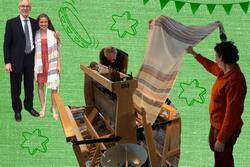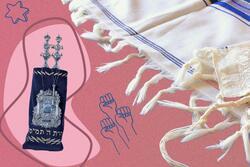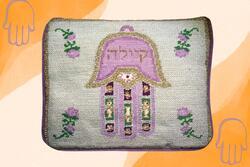Honoring the Women of the Wall With My Tallit
I was twelve, driving with my mom, when I told her about how I wanted the tallit for my upcoming bat mitzvah to have more than the traditional stripe (which represents a person's duties as a Jew) and also include a design of Jerusalem's Old City. In response, my mom offhandedly mentioned how special it is that I will have a tallit and will be reading Torah. I turned to my mom, confused, and asked why it was so special. My mom gave me an explanation that entirely changed the way I perceived my bat mitzvah. Previously, I had seen it as an important ritual that signified the change from childhood into adulthood. However, this conversation turned it from a solely Jewish experience into a feminist Jewish experience.
In the car that day, she explained that it was not part of the culture for a woman to read Torah for her bat mitzvah when she was growing up in Israel. My mom always felt that she had missed something important because she never went through the process of being called up to the Torah for this key point in her life. It was because of this that she worked so hard to ensure I would be able to undergo this powerful experience.
Even though I grew up in the United States, where it is more common for women to read Torah, my mom still had to put effort into ensuring that I could go through this process. Our modern Orthodox synagogue usually didn’t let women read, but my mom made sure my name was down to read the Megillah, which traditionally is a mitzvah for anyone of any gender to read, at my bat mitzvah. When we became part of a Conservative synagogue, which has always been much more accepting of women's leadership compared to the Orthodox tradition, she was the one ensuring that I was able to get lessons on chanting Torah trope and that I had a parasha. In that moment in the car I understood how powerful it was that I, as a woman, was able to have an aliyah while wearing my own tallit. It further highlighted that I was so fortunate to have a mom who would fight for me, even in a place where it was less accepted. It was this discussion and the realization that followed that made me decide that I wanted a tallit that represented both my Jewish and feminist identities.
This understanding then went on to open my eyes to different moments in my life in which I was given an opportunity that other women in my family were not. During the High Holidays services at our synagogue, there is a point at which you can go up to the Torah and touch it with your tzitzit, then touch it to your lips. My mom does not have a tallit and before our b'nai mitzvahs, neither did my brother or I. However, my mom would always be with my dad under his tallit and would use his tzitzit to touch the Torah. That is because my parents have turned it into a ritual together in which they approach the Torah as one. My mom did not get to read Torah, yet she still feels a close spiritual connection between a tallit and the Torah. My tallit holds the names of the four mothers, Sarah, Rivkah, Rachel, and Leah, in each corner where the tzitzit is attached. Now, each High Holiday when I press my tzitzit to the Torah, I am connecting to the four mothers as well as my mother, who does not have her own tzitzit, yet still finds ways to connect with the Torah through a tallit.
The tallit I chose, which I feel represents my identities, was designed by Yair Emanuel to honor the Women of the Wall. This group of women wear tallitot to the Kotel, the Western Wall in Jerusalem, and read out from the Torah, a practice which is considered inappropriate by the Israeli government, and illegal by the Orthodox authorities who control access to the Wall. Although men can use the Torah scrolls provided for public use, women have had them confiscated and the Women of Wall have had to smuggle in Torah scrolls. During prayer they find themselves being spit on, having things thrown on them, and sometimes they would be detained for interrogation. Yet they continue to publicly read Torah each Rosh Chodesh, have bat mitzvah services, recite kaddish, and write letters to the government advocating for their rights to pray at the Wall.
By choosing this tallit, I am also honoring the hard work of other women that allowed me to go through this process. However, it is also important to acknowledge that while I feel a spiritual Jewish connection to wearing a tallit and feel it is a part of my Jewish feminist identity, the identity of a Jewish woman is not always reflected through wearing a tallit or the process of reading Torah. For me, though, my tallit represents the spiritual experience of my bat mitzvah. Every time I wrap it around my shoulders, I remember doing so at my bat mitzvah for the first time before I read Torah, a moment that still resonates with me four years later.
This summer, as I stood next to my mom with my tallit wrapped around my shoulders, I watched my grandma stand with a borrowed tallit around her shoulders, smiling ear to ear as she held a Torah for the first time. My grandma, who still lives in Israel, is now eighty-two, and it was only at my brother's bar mitzvah that she got a chance to hold a Torah. As the first woman in my family to go up and chant Torah with my own tallit wrapped around my shoulders, I have been given an opportunity that no woman in my family was given before. My tallit has become a representation for me of how far women’s rights in Judaism have progressed.
This piece was written as part of JWA’s Rising Voices Fellowship.








The young women's endearment to Judaism helps make history as women, with the inspiration of Women of The Wall, find their unique and special place in this troubled world.
Beautifully written, thoughtful piece. Made me think about both my and my mother’s positions growing up in an orthodox household. Look forward to reading more by this writer.